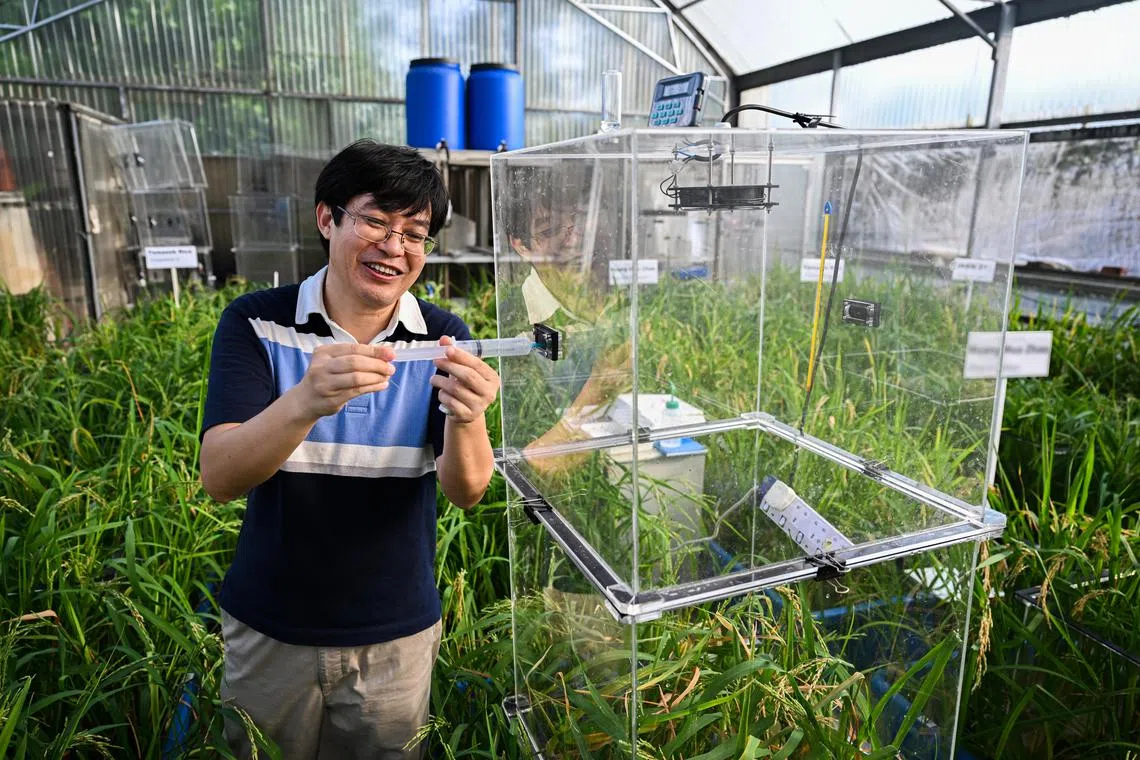Singapore lab makes strides in identifying optimal rice growing conditions with reduced methane
Sign up now: Get ST's newsletters delivered to your inbox

Mr Ali Ma, senior research officer at Temasek Life Sciences Laboratory, drawing out a methane gas sample from a rice paddy covered in a chamber.
ST PHOTO: AZMI ATHNI
Follow topic:
SINGAPORE – Like extracting a biological sample to gauge a person’s health, a researcher from Temasek Life Sciences Laboratory (TLL) sticks a needle into a sealed box with a rice plant inside to draw out an air sample.
The amount of methane from the rice plant is then measured – an important metric for a project seeking to decarbonise rice.
Methane is the second-most abundant greenhouse gas after carbon dioxide, accounting for about 20 per cent of global emissions. Methane from rice farming alone makes up 1.5 per cent of greenhouse gas emissions.
The amount of methane produced can be affected by different conditions such as chemicals added in the soil, rice varieties and irrigation methods.
The gas is produced as anaerobic microbes feed on organic matter in the waterlogged soils of rice fields, where farmers use a flooding practice to control pests and weeds.
Rice itself also produces varying levels of methane, depending on the variety.
Different conditions have been tested at the lab on the grounds of the National University of Singapore (NUS) since 2022, with the aim of reducing methane emissions by at least 20 per cent, compared with current practices without any intervention.
The project also aims to get rice farming to adapt to climate change and, at the same time, improve rice yields by 5 per cent by using more climate-resilient varieties, enhancing soil health, and using optimised levels of water and fertilisers.
While rice feeds half of the world’s population, it is also responsible for 1.5 per cent of greenhouse gas emissions.
Changing weather patterns due to human emissions of greenhouse gases have also fuelled climate change, affecting food production globally.
The project’s first phase of research has shown a reduction in methane emissions, while rice production improved, said NUS Adjunct Professor Naweed Isaak Naqvi, a senior investigator at TLL.
He presented the research to the regional philanthropic community on Friday morning at the Philanthropy Asia Summit, where it was one of eight projects featured.
Funds of an undisclosed sum are being raised to implement TLL’s rice research outside its labs.
One of the project scientists, senior principal investigator Srinivasan Ramachandran, said the project’s next phase will be in the fields in India, Indonesia and Laos, working with local farmers and scientists on about 100ha of plantation in each country.
He added: “We want to further study how to manage and preserve soil health, so that less methane can be produced, while studying how to make rice crops more drought-resistant.”

